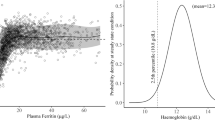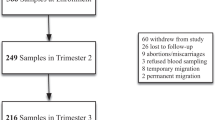Abstract
Objective: To investigate haematological and biochemical iron indices in relation to malaria, gravida, and dietary iron status in rural pregnant Malawian women.
Design: In this self-selected sample, haemoglobin, haematocrit, red cell indices, serum ferritin, serum iron, serum transferrin, and serum transferrin receptor (TfR) were measured. Infection was assessed by a malaria slide, serum C-reactive protein, and white blood cell count. Dietary iron variables were measured by three 24-h interactive recalls.
Setting and subjects: 152 rural pregnant women recruited at 24 weeks gestation while attending a rural antenatal clinic in Southern Malawi; 36% were primagravid; 43% were gravida 2–4; 26% were gravida >5.
Results: Of the women, 69% (n=105) were anaemic (haemoglobin <110 g/l); 37% (n=39) had anaemia and malarial parasitaemia on the test day; 17% (n=26) with malaria were also classified with iron deficiency (ID) anaemia (based on serum ferritin ≤50 μg/l and Hb <110 g/l) while an additional seven with malaria were classified with ID without anaemia. In malarial-free subjects, 32% were classified with IDA (serum ferritin <12 μg/l and Hb <110 g/l) and 17% with ID (serum ferritin <12 μg/l; Hb ≥110 g/l). Serum TfR concentrations were elevated in anaemic women (P<0.01). In non-malarial parasitaemic subjects, serum TfR correlated negatively with haemoglobin (r=−0.313; P<0.001) but not serum ferritin. Of the women, 49% were at risk for inadequate iron intakes. Most dietary iron was non-haem; plant foods provided 89%; flesh foods (mainly fish) only 9%. Malarial parasitaemia and intakes of available iron impacted significantly on iron status.
Conclusion: Anaemia prevalence from all causes was high (that is, 69%); three factors were implicated: malaria, and deficiencies of iron and possibly folate, induced partly by an inadequate dietary supply and/or secondary to malarial parasitaemia.
Sponsorship: International Development Research Centre (IDRC) of Canada. Opportunities for Micronutrient Interventions (OMNI) Project. Natural Sciences and Engineering Research Council of Canada.
This is a preview of subscription content, access via your institution
Access options
Subscribe to this journal
Receive 12 print issues and online access
$259.00 per year
only $21.58 per issue
Buy this article
- Purchase on Springer Link
- Instant access to full article PDF
Prices may be subject to local taxes which are calculated during checkout
Similar content being viewed by others
Author information
Authors and Affiliations
Contributions
Guarantor: Professor RS Gibson
Contributors: Janet-Marie Huddle recruited the participants, analysed the blood samples, collected the dietary data, and participated in the statistical analyses, data interpretation, and manuscript preparation. Rosalind Gibson was responsible for the design of the study, overall project supervision, and interpretation and preparation of the manuscript. Tim Cullinan was involved in the study design, obtaining ethical approval and community support for the study in Malawi, and supervision of the field work in Malawi.
Corresponding author
Rights and permissions
About this article
Cite this article
Huddle, JM., Gibson, R. & Cullinan, T. The impact of malarial infection and diet on the anaemia status of rural pregnant Malawian women. Eur J Clin Nutr 53, 792–801 (1999). https://doi.org/10.1038/sj.ejcn.1600851
Received:
Revised:
Accepted:
Published:
Issue Date:
DOI: https://doi.org/10.1038/sj.ejcn.1600851
Keywords
This article is cited by
-
Association of maternal BMI during early pregnancy with infant anemia: a large Chinese birth cohort
Nutrition & Metabolism (2020)
-
Anaemia and associated risk factors among pregnant women in Gilgel Gibe dam area, Southwest Ethiopia
Parasites & Vectors (2012)
-
An update of malaria infection and anaemia in adults in Buea, Cameroon
BMC Research Notes (2010)
-
Malaria during pregnancy and foetal haematological status in Blantyre, Malawi
Malaria Journal (2005)



